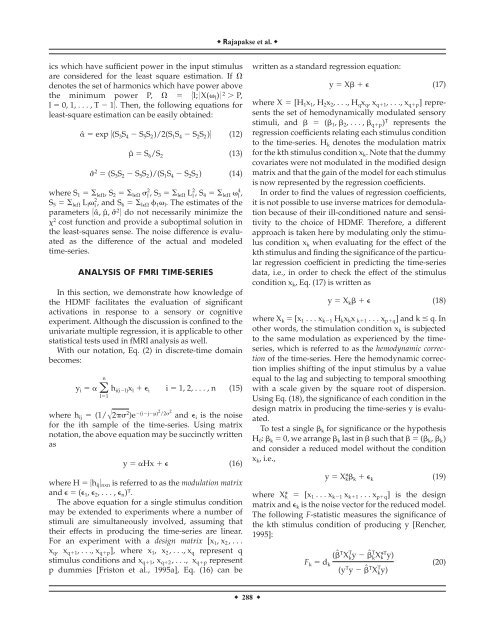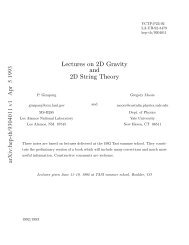Modeling hemodynamic response for analysis of functional MRI time ...
Modeling hemodynamic response for analysis of functional MRI time ...
Modeling hemodynamic response for analysis of functional MRI time ...
You also want an ePaper? Increase the reach of your titles
YUMPU automatically turns print PDFs into web optimized ePapers that Google loves.
Rajapakse et al. <br />
ics which have sufficient power in the input stimulus<br />
are considered <strong>for</strong> the least square estimation. If <br />
denotes the set <strong>of</strong> harmonics which have power above<br />
the minimum power P, 5l;0X( l )0 2 P,<br />
l 0,1,...,T16. Then, the following equations <strong>for</strong><br />
least-square estimation can be easily obtained:<br />
ˆ exp 5(S 3 S 4 S 5 S 2 )/2(S 1 S 4 S 2 S 2 )6 (12)<br />
µˆ S 6 /S 2 (13)<br />
ˆ 2 (S 3 S 2 S 5 S 2 )/(S 1 S 4 S 2 S 2 ) (14)<br />
where S 1 l ,S 2 l l 2 ,S 3 l L l 2 ,S 4 l l 4 ,<br />
S 5 l L l l 2 , and S 6 l 1 l . The estimates <strong>of</strong> the<br />
parameters 5ˆ,µˆ,ˆ26 do not necessarily minimize the<br />
2 cost function and provide a suboptimal solution in<br />
the least-squares sense. The noise difference is evaluated<br />
as the difference <strong>of</strong> the actual and modeled<br />
<strong>time</strong>-series.<br />
ANALYSIS OF F<strong>MRI</strong> TIME-SERIES<br />
In this section, we demonstrate how knowledge <strong>of</strong><br />
the HDMF facilitates the evaluation <strong>of</strong> significant<br />
activations in <strong>response</strong> to a sensory or cognitive<br />
experiment. Although the discussion is confined to the<br />
univariate multiple regression, it is applicable to other<br />
statistical tests used in f<strong>MRI</strong> <strong>analysis</strong> as well.<br />
With our notation, Eq. (2) in discrete-<strong>time</strong> domain<br />
becomes:<br />
n<br />
y i l1<br />
h i(il) x l i i1,2,...,n (15)<br />
where h ij (1/2 2 )e (ijµ)2 /2 2 and i is the noise<br />
<strong>for</strong> the ith sample <strong>of</strong> the <strong>time</strong>-series. Using matrix<br />
notation, the above equation may be succinctly written<br />
as<br />
y Hx (16)<br />
where H 5h ij 6 nxn is referred to as the modulation matrix<br />
and ( 1 , 2 ,..., n ) T .<br />
The above equation <strong>for</strong> a single stimulus condition<br />
may be extended to experiments where a number <strong>of</strong><br />
stimuli are simultaneously involved, assuming that<br />
their effects in producing the <strong>time</strong>-series are linear.<br />
For an experiment with a design matrix [x 1 ,x 2 ,...<br />
x q , x q1 ,...,x qp ], where x 1 , x 2 ,...,x q represent q<br />
stimulus conditions and x q1 ,x q2 ,..., x qp represent<br />
p dummies [Friston et al., 1995a], Eq. (16) can be<br />
written as a standard regression equation:<br />
y X (17)<br />
where X [H 1 x 1 ,H 2 x 2 ,...,H q x q ,x q1 ,...,x qp ] represents<br />
the set <strong>of</strong> <strong>hemodynamic</strong>ally modulated sensory<br />
stimuli, and ( 1 , 2 ,..., qp ) T represents the<br />
regression coefficients relating each stimulus condition<br />
to the <strong>time</strong>-series. H k denotes the modulation matrix<br />
<strong>for</strong> the kth stimulus condition x k . Note that the dummy<br />
covariates were not modulated in the modified design<br />
matrix and that the gain <strong>of</strong> the model <strong>for</strong> each stimulus<br />
is now represented by the regression coefficients.<br />
In order to find the values <strong>of</strong> regression coefficients,<br />
it is not possible to use inverse matrices <strong>for</strong> demodulation<br />
because <strong>of</strong> their ill-conditioned nature and sensitivity<br />
to the choice <strong>of</strong> HDMF. There<strong>for</strong>e, a different<br />
approach is taken here by modulating only the stimulus<br />
condition x k when evaluating <strong>for</strong> the effect <strong>of</strong> the<br />
kth stimulus and finding the significance <strong>of</strong> the particular<br />
regression coefficient in predicting the <strong>time</strong>-series<br />
data, i.e., in order to check the effect <strong>of</strong> the stimulus<br />
condition x k , Eq. (17) is written as<br />
y X k (18)<br />
where X k [x 1 ...x k1 H k x k x k1 ...x pq ] and k q. In<br />
other words, the stimulation condition x k is subjected<br />
to the same modulation as experienced by the <strong>time</strong>series,<br />
which is referred to as the <strong>hemodynamic</strong> correction<br />
<strong>of</strong> the <strong>time</strong>-series. Here the <strong>hemodynamic</strong> correction<br />
implies shifting <strong>of</strong> the input stimulus by a value<br />
equal to the lag and subjecting to temporal smoothing<br />
with a scale given by the square root <strong>of</strong> dispersion.<br />
Using Eq. (18), the significance <strong>of</strong> each condition in the<br />
design matrix in producing the <strong>time</strong>-series y is evaluated.<br />
To test a single k <strong>for</strong> significance or the hypothesis<br />
H 0 : k 0, we arrange k last in such that ( k , k )<br />
and consider a reduced model without the condition<br />
x k , i.e.,<br />
y X* k k k (19)<br />
where X* k [x 1 ...x k1 x k1 ...x pq ] is the design<br />
matrix and k is the noise vector <strong>for</strong> the reduced model.<br />
The following F-statistic measures the significance <strong>of</strong><br />
the kth stimulus condition <strong>of</strong> producing y [Rencher,<br />
1995]:<br />
(ˆ T X T k y ˆk<br />
T X* kT y)<br />
F k d k<br />
(y T y ˆT X T k y)<br />
(20)<br />
288
















